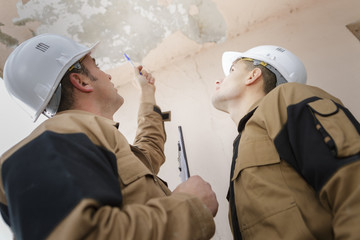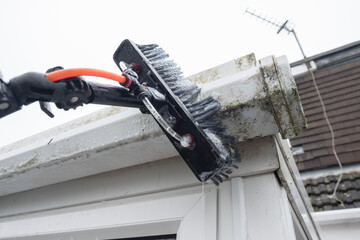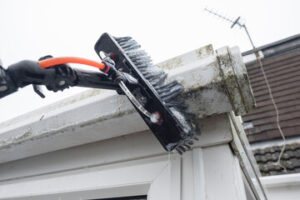Taking preventative measures to avoid water damage can help reduce the overall costs of restoration. Regular inspections and replacement of hoses can also lower the risk of costly issues in the future.

The first step in the restoration process is to assess the extent of the damage. Water mitigation experts look for standing water, stains, and swelling. They will then categorize the damage. Contact Water Damage Restoration Utah for professional help.
The next step of water restoration is to dry the affected building materials. This involves circulating warm, dry air throughout the space and regulating humidity with dehumidifiers. During this phase, water and moisture are removed from the damaged materials, which helps prevent future damage and reduces mold growth.
The duration of this process depends on the severity of the water damage and type of material. However, the sooner drying is started, the better. If left untreated, water and moisture will continue spreading through building materials and causing additional damage.
This is why it is important to call a professional right away. Water mitigation professionals will use high-powered fans and air movers to promote airflow and accelerate the drying process. They also utilize industrial dehumidifiers to remove moisture from building materials like drywall and flooring.
It is important to note that it may take a few days for the moisture in building materials to reach equilibrium. During this time, it is critical to monitor the progress and make any necessary adjustments. Moisture levels are also evaluated and classified using a variety of tools, including moisture maps. These maps provide an accurate depiction of moisture levels and help guide the remediation process.
Once the moisture in building materials reaches equilibrium, the drying process is complete and the property is ready to be occupied. Mitigation teams may recommend temporary solutions to protect the property while the area dries, such as covering holes with tarps and boarding up broken windows.
In the commercial setting, water damage can be especially devastating, interrupting business operations and causing potential safety concerns for employees and customers. A quick response and effective water damage remediation can minimize loss of revenue, equipment, and inventory. It is also critical to understand the different types of water damage so that the appropriate remediation strategies can be implemented. For example, contaminated water (often referred to as grey water) is typically caused by overflowing toilets and other leaking appliances, and can quickly spread bacteria and other harmful microorganisms throughout the building. To mitigate this risk, it is recommended that a disinfection treatment be performed in conjunction with the drying process.
Cleaning
Water damage restoration involves more than just cleanup. It requires sanitizing and disinfecting to make sure that any bacteria or other microorganisms are removed from the affected area. This helps ensure that the resulting indoor air quality is safe for occupants and also that any materials that have been exposed to water are free from harm. This is especially important for porous materials like drywall and wood, which can absorb harmful substances and odors.
The cleaning and sanitizing process often starts with the removal of standing water using pumps or vacuums. This can take a while depending on the amount of water damaged materials and the size of the affected area. Once all excess water is removed, the drying process can begin. This may involve dehumidifiers and other specialized equipment to remove moisture from the air, walls, and floors of the property. It can also include sanding or other steps to remove any water spots or discoloration from wood and drywall.
During this phase of restoration, any items that have been destroyed or weakened by the water are repaired or replaced. This can include everything from tearing out and replacing carpeting to patching drywall and restoring flooring. Typically, structural repairs will be completed as soon as possible after the water damage event to minimize long-term problems.
In the final stages of water damage restoration, professionals will inspect the property to determine if any repairs are needed. This step usually involves checking for any damage to electrical systems, pipes, and appliances. It can also involve evaluating the structure of the building and identifying any potential problems that may need to be addressed in the future.
The most important thing to remember when it comes to water damage is that prompt action is key. Waiting even a few hours can lead to more extensive and costly damages. The most effective mitigation strategies include turning off electricity to any areas that are affected by water, removing any electrical hazards, and preventing further damage by shutting off the water source. A professional team with specialized equipment can help speed up this process and prevent further damage.
Structural Repairs
Structural repairs are repairs that involve the building’s foundation, walls, beams and other major structural elements. They are typically done on older buildings that have started showing signs of structural instability or don’t fully meet modern safety and code standards.
Repairs to these elements are a critical part of maintaining the integrity and safety of a building. These can range from repairing cracks in the walls and foundation to replacing damaged beams. Structural repairs are a much more extensive and involved process than general repair work and typically require the expertise of a certified structural engineer.
If you have a structural issue, it’s important to get it fixed as soon as possible to prevent further damage and to protect your property value. If left untreated, cracks in your home’s foundation, sagging floors, and leaning retaining walls can become worse, causing serious problems for you and your family.
Many factors can contribute to a structural problem, including soil movement, water damage, aging materials, and poor construction. While some issues are easy to fix, others can be extremely costly and complex.
Getting structural repairs done early can help you save money, minimize safety risks, and maintain the value of your home or commercial property. It is also a great way to prevent future issues that can lead to expensive repairs or even the need for demolition and rebuilding.
The biggest challenge with structural repairs is the complexity of the task and the need for a skilled engineer to evaluate the problem and devise a solution. Structural issues can be very dangerous for occupants, so it’s important to seek out expert help as soon as you notice any signs of damage.
Depending on the extent of the damage, it can take weeks or months to complete structural repairs. During this time, it’s important to maintain a clear line of communication with your contractor so that they can keep you updated as the work progresses. This will also give you a better idea of how long the project is likely to take and what it might cost, so that you can plan accordingly.
Mold Remediation
Mold is a dangerous fungus that grows in moist environments and can cause a variety of health issues. It can also eat away at materials like wood and drywall, compromise structural integrity, and degrade indoor air quality. While some strains of mold are not toxic, others may produce toxins or irritants that can aggravate respiratory problems. For this reason, it is important to address a water damage problem as soon as possible and take precautions to prevent mold growth.
Water damage restoration companies provide a range of services to address the root cause of the problem and prevent future mold infestations. These include inspection and assessment, mold remediation, and structural repairs. To begin the process, professionals assess the area using moisture meters and other tools to determine the extent of the damage. They also inspect the property for signs of mold, such as stains, discoloration, and odors.
When they detect the presence of mold, professionals seal off the affected areas with specialized equipment. This helps to prevent mold spores from spreading throughout the building during the cleanup process. It is especially important to contain the affected area in areas with extensive water damage, such as the attic or basement.
The next step is to remove the impacted materials and clean and disinfect the remaining surfaces. This may involve removing and replacing drywall, carpeting, insulation, and other items. It is also important to make structural repairs to prevent further damage and ensure the property is safe for habitation.
Once all contaminated materials are removed, professional-grade chemical treatments can be applied to kill any residual spores and prevent mold from growing back. The last step is to dry the impacted area, which can be done with industrial-grade air movers and dehumidifiers.
Mold will start to grow within 24 hours of water damage, so it is essential to act quickly. Mold growth can lead to a wide variety of health issues and can significantly decrease the value of your home or business. To avoid mold growth, be sure to fix leaky roofs and pipes promptly and regularly clean crawl spaces and attics to prevent moisture buildup.



